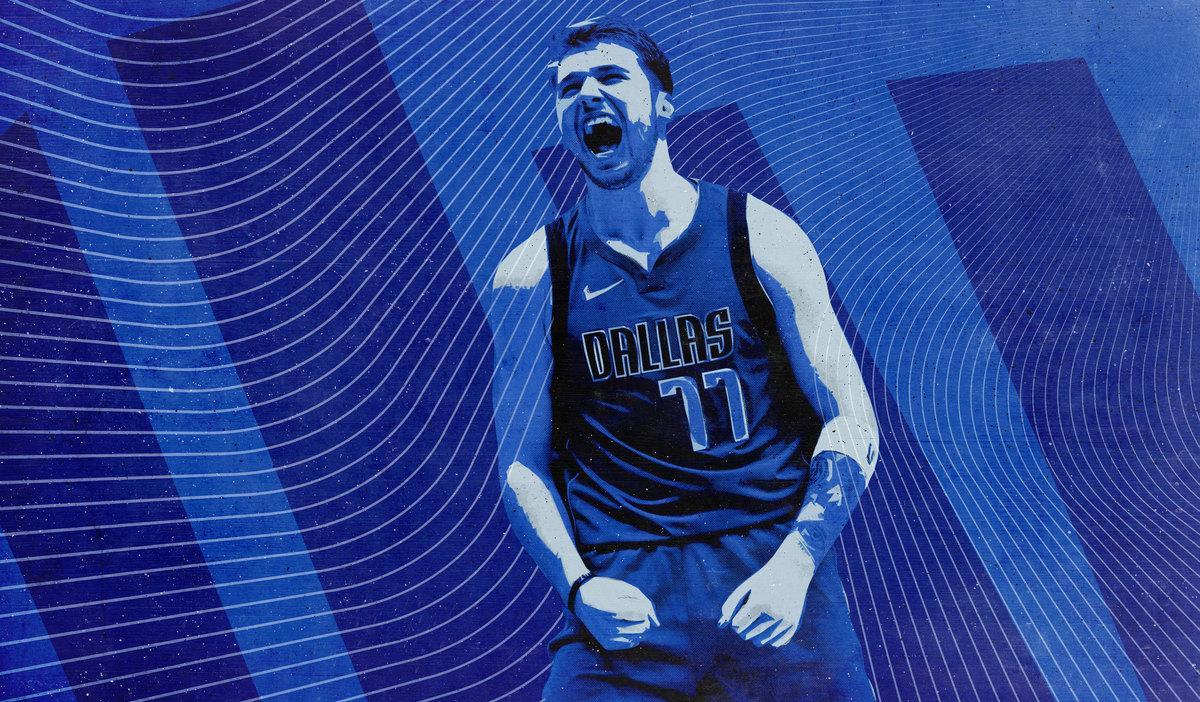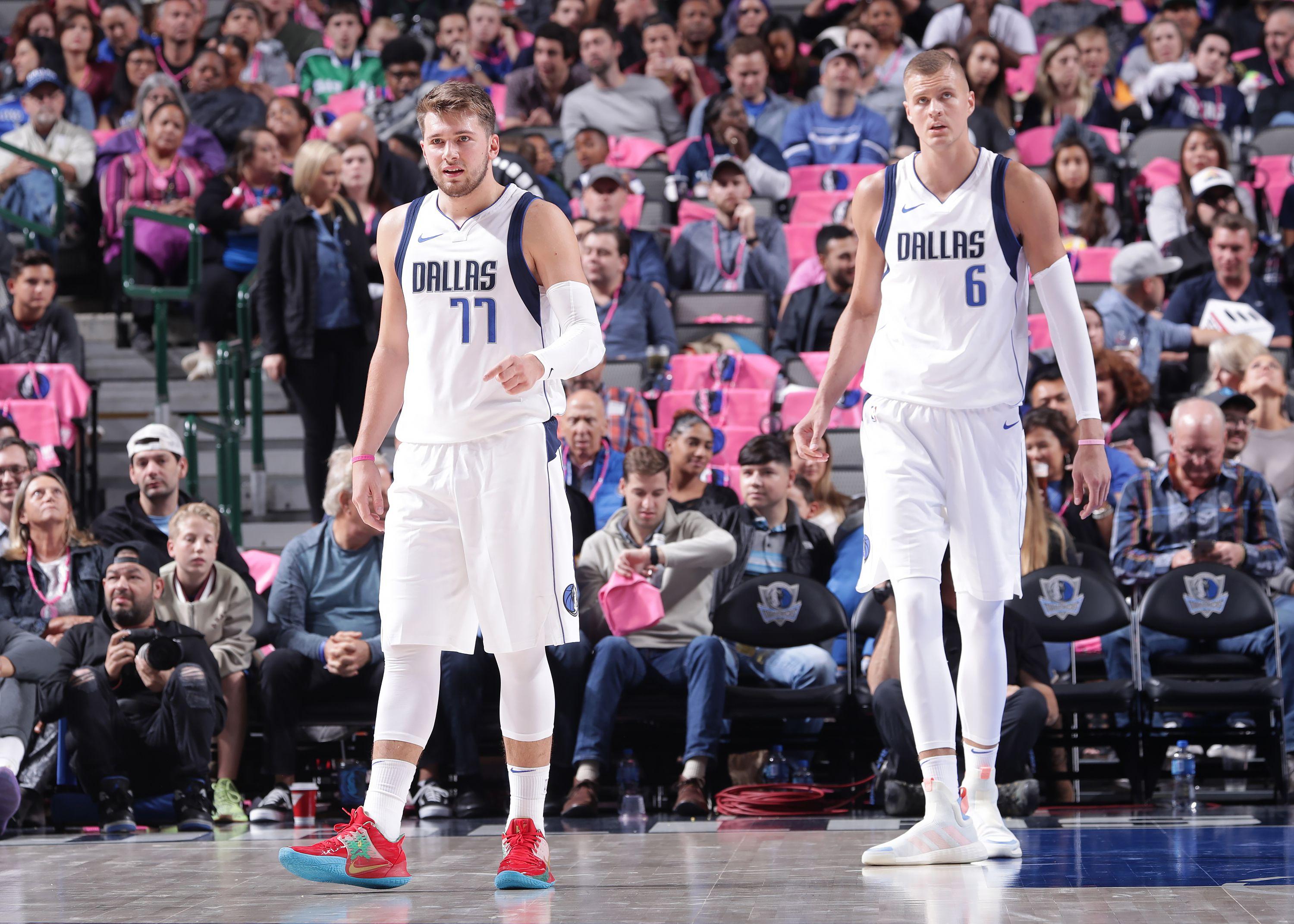
At the end of practice at the Dallas Mavericks’ training facility a few weeks ago, Luka Doncic was working on one-on-one moves against assistant coach Jamahl Mosley. He faced up Mosley on the baseline, took one dribble, and stepped back to make a fadeaway corner 3. Mosley threw up his hands in disgust.
Doncic laughed as he walked away, telling Mosley and everyone in earshot, “I’ve been making that shot since I was 15.”
The practice court is where Doncic, 20, is in his element. He doesn’t talk much in interviews with the media, but he’s always talking between the lines.
“It reminds me of Dirk,” longtime Dallas guard J.J. Barea told me after a recent practice. “Me and Dirk were always talking, going back at each other, 24-7.”
Most of Luka’s friendly trash talk revolves around how much professional success he has already had. He’s the rare second-year NBA player who is more experienced than most of his teammates. The Slovenian signed with Real Madrid at 13 and was playing in EuroLeague games at 16. Ask any question about his game and the answer usually comes back to his track record.
Physical defense? “I got used to it last year. And the year before in Europe. And the year before that. So I would say I’m pretty used to it,” Doncic said after a series of chippy fouls between him and Bradley Beal on Dallas’s opening night, which ended in an ejection for the Wizards star.
The pressure of replacing Dirk Nowitzki? “I had pressure since I was 16, so I like pressure,” he said on media day.
Dealing with off-court attention? “That’s since I was 16. I had guys at Real Madrid help me focus on basketball and keep working,” he told NBATV in training camp.
Luka has always been ahead of his time on the court. In his first practice as an 8-year-old at the Olimpija Basketball School in Ljubljana, Slovenia, he was so dominant that he was moved up to play against older kids after 16 minutes. Over the next decade, he steadily climbed the ranks of European basketball and became the MVP of the EuroLeague Final Four at 19.
Even the leap to the NBA didn’t slow him down. Doncic was the runaway Rookie of the Year winner, and he immediately stepped in for Nowitzki as the new face of the Mavs.
But even a wunderkind needs time to grow. With expectations sky high coming in his second season, Doncic and the Mavs front office are focusing on three key areas in order to take Luka’s game to the next level and secure a playoff spot in the crowded Western Conference.

The biggest splash that Doncic made in the offseason came on Instagram. He posted a picture of himself in August looking lean and lugging around a set of weights across his driveway, and it went viral.
“He worked on his body in the offseason, and it’s clear,” Mavs GM Donnie Nelson told me. “He came in loaded for buck this year.”
It reminds me of Dirk. Me and Dirk were always talking, going back at each other, 24-7.J.J. Barea
It was a big change from the previous summer, when the Mavs asked Doncic to rest and recuperate because of the miles he had put on his body playing nonstop for two years for Real Madrid and the Slovenian national team. As a result, Doncic showed up to his first training camp behind the curve on conditioning, and then ran out of steam during the second half of the season, especially after Dallas emptied out its roster in late January to acquire Kristaps Porzingis.
“He had a really good summer of lifting. I could see it the other day when we were doing weights. I was actually impressed by what he was squatting,” Mavs big man Maxi Kleber said with a laugh. “He looked quicker and got more explosive.”
Doncic hasn’t had nearly the same type of physical transformation as Porzingis, who looks significantly bigger than he was in his time in New York. But Luka’s offseason work can be seen is his play. He has improved in nearly every major statistical category while leading the Mavs to a 3-1 start:
The Luka Doncic Project, Part 2
Through the first week of the season, Doncic is taking a higher percentage of his shots at the rim (25 percent) than he did last season (20.9 percent) and making them at a much higher rate (77.8 percent compared with 63.7 percent). It’s a matter of inches—being a half-beat quicker on his drives means that he doesn’t have to settle for lower-percentage shots farther away from the rim or deal with quite as many defenders rotating over to stop him.
One of three things usually happens when Luka has the ball: He either takes a 3 off the dribble, gets all the way to the rim, or creates a shot for someone else. He has taken that analytics-friendly approach to a James Harden–like extreme this season. The percentage of his shots in the midrange between the paint and the 3-point line has dropped from 14.5 percent all the way to 4.2 percent. The stepback jumper is one of his favorite moves; now, he’s literally taking one more step back on many of his shots.
“Getting a third more [points] on the same shots? Vegas would kill for those odds,” Nelson said.
Harden is a different kind of superstar, and Doncic is one of his first disciples. The best example of the Beard’s unique skill set is the “Harden triple-double,” or when a player hits double digits in 3-point attempts, free throw attempts, and assists. There have been 105 such games in NBA history; Harden has 47 of them. Doncic had one last season, and he’s almost achieved two more in just four games this season.
Harden and Doncic are also two of only six players in the NBA this season averaging at least six 3-point attempts, free throw attempts, and assists per game:
“Harden Triple-Double” Candidates
Free throw attempts are the key to their consistency, because even the best 3-point shooters have nights when their shot isn’t falling. Luka, like Harden, has an unusual ability to change speeds and decelerate on drives, and he’s more than willing to sell the call. He already knows all the tricks when it comes to seeking out and creating contact:
The big advantage that Doncic has over other proto-Hardens is his size (6-foot-7, 230 pounds). He’s the only player on that list bigger than Harden.
“[Doncic] learned at a very young age how to use his body, especially against bigger guys to get an extra bump,” said Kleber, who came to the NBA from Germany at 25, about Doncic’s ability to draw contact.
The overseas experience has also given Doncic a better understanding than most young players of how to bend the rules. After Dallas’s loss to the Trail Blazers on Sunday, he was mad that he took “only” 14 free throw attempts.
The other big difference for Doncic this season is what happens once he gets into the lane. There’s almost no one there. The defense has to account for a 7-foot-3 center spotting up 30-plus feet from the basket.
Porzingis is shooting 33.3 percent from 3 on a mind-boggling 7.5 attempts per game this season. It’s the second-most 3s that a 7-footer has attempted in NBA history, behind only a reinvented Karl-Anthony Towns, who is shooting 8.5 3s per game this season. To give you an idea of how fast the sport is changing, the top five seasons in that category have all come in the past two years.
“Fours are really kind of now 3s. And I think slowly 5s are becoming 4s,” Nelson said. “It’s a good thing because skill is being injected in those positions.”
The Brook Lopez effect is real. Lopez transformed the Bucks offense last season by logging 6.3 3-point attempts per game from the center position, and there is now a wave of copycats around the league. Porzingis has opened things up for Luka this season in the same way that Lopez helped Giannis Antetokounmpo. And the Mavs offense, at least so far, has received a similar boost, jumping from no. 20 in offense last season all the way up to no. 4.
“It’s the way the league is going,” Blazers coach Terry Stotts said. “We are giving up a lot of 3s right now. The whole league is.”
Doncic and Porzingis have already shown some intriguing flashes in the two-man game. It’s hard to stop a pass from a 6-foot-7 player to a 7-foot-3 one:
Porzingis has never played with a playmaker like Doncic; his starting point guards in his three seasons with the Knicks were Jose Calderon, Derrick Rose, and Jarrett Jack. But that’s not the only reason why the two European stars are a good fit.
Their biggest strengths cover for the other’s weaknesses. Porzingis’s shot-blocking can protect Luka on defense. Conversely, Doncic’s elite rebounding ability can make up for some of Porzingis’s issues in the paint. Porzingis is a surprisingly poor rebounder for a 7-foot-3 player, with a career average of only 7.1 rebounds per game; Doncic, however, is second behind only Russell Westbrook in rebounds this season among players 6-foot-7 and under.
But integrating Porzingis into the offense hasn’t been seamless. He hadn’t played in 20 months before this season, as a result of tearing his ACL in February 2018, and he’s still regaining his timing on the court.
Like everyone else in Dallas, Porzingis also has to figure out how to play next to such a ball-dominant guard. Doncic is no. 1 in the league in touches per game this season (104) and average time with the ball per possession (9.3 seconds), far ahead of Harden at no. 2 (7.9). Porzingis’s usage rate, per NBA Advanced Stats, jumps from 26.4 in 102 minutes with Doncic to 41.4 in 24 minutes without him.
The difference with Luka is that he’s 5 inches taller than [Steve] Nash. And KP is 3 inches taller than Dirk. These guys are just really big. To go where we want to go, it’s getting those guys to play together.Donnie Nelson
It’s hard to find a balance. Porzingis shouldn’t have as much offensive responsibility as Doncic, but he’s also more than just a spot-up shooter. He can create his own shot off the dribble and have the offense run through him. The trick for the Mavs will be finding ways to feature Porzingis when he’s playing with Doncic without it becoming a rote exercise of taking turns while the other watches.
After their first regular-season game together, Porzingis said the chemistry “wasn’t great. Luka did a lot of stuff individually. I did some stuff for myself individually. But in the end, we are going to get to that. We don’t need to rush anything. We like playing with each other.”
The Mavs know that it will not be an overnight process. As the league seemingly moves from an era of Big Threes to Big Twos, the hope is that Porzingis and Doncic can spend the next decade growing together on and off the court.
“[It’s like] if you had [Steve] Nash and Dirk, and we were able to keep that group together,” Nelson said. “The difference with Luka is that he’s 5 inches taller than Nash. And KP is 3 inches taller than Dirk. These guys are just really big. To go where we want to go, it’s getting those guys to play together.”
One of the most encouraging moments of the new season for Dallas came when Doncic was on the bench. The Mavs were down nine points to the Nuggets in Denver when Doncic came out of the game near the end of the third quarter. He then watched Porzingis and the reserves go on a 30-12 run over the next eight minutes, helping the Mavs pull out a 109-106 win on the road.
Dallas once again struck out on big names in free agency, but it was able to make some under-the-radar moves to improve their perimeter firepower. The Mavs added Seth Curry, one of the most accurate 3-point shooters in NBA history, and Delon Wright, who broke out during the second half of last season after a trade to Memphis. The Mavs have more depth than they have had in years. Coach Rick Carlisle never misses a chance to talk up Jalen Brunson, who slipped to the no. 33 pick in 2018 despite winning the Wooden Award and helping Villanova to two NCAA championships in three seasons.
For a coach as curmudgeonly as Carlisle, this counts as high praise: “It’s always a job of a head coach to manage expectations. But I’m probably less inclined to try and quell excitement than I was a few years ago. I’m not encouraging anybody to not have a great amount of interest in this team.”
But for the Mavs to reach those expectations, Doncic needs to learn how his teammates can make the game easier on him. There’s a temptation for a young player with Luka’s ability to try to do everything. Perhaps as a result, he’s tied for sixth in the NBA in turnovers per game and is getting all of his offense the hard way: According to the tracking numbers at Synergy Sports, Doncic has taken only six catch-and-shoot jumpers compared to 19 off the dribble.
Doncic has the ability to tweak his offensive approach. He had success playing off the ball last season: He was in the 63rd percentile among players leaguewide after coming around off-ball screens, and the 77th percentile when shooting off cuts. One of the most intriguing aspects of Luka’s play at Real Madrid was the way he alternated between playing on and off the ball. Doing the same thing in the NBA would empower his teammates and allow them to benefit from the attention that he draws without his having to do nearly as much work.
“We have to do a better of job setting screens on [Doncic] and getting him free. Sometimes playing him off the ball so that he doesn’t get tired bringing it up,” Barea said. “Doing that for 35 to 40 minutes isn’t easy in this league.”
The other benefit of Doncic doing less on offense is redistributing some of that energy to the other end of the floor. Scoring points shouldn’t be an issue for the Mavs this season; their ability to get stops will determine whether they make the playoffs. The results have been mixed so far—they are no. 21 on defense in the NBA—and Doncic has been one of the main issues. Opposing teams often target him. This is what happened when the Blazers ran a play to get Damian Lillard isolated on him in the final seconds of the game:
Luka’s lack of elite athleticism will always put a ceiling on his defense. But everyone in Dallas believes his combination of size, strength, and intelligence should allow him to at least hold his own.
“[Doncic] is smart enough to be good on defense,” Barea said. “He’s long enough and big enough. We have to put him on the right guy every night. I think he likes to guard bigger guys, slower guys.”
Most second-year guards are still figuring out their games. That is not an issue for Doncic. He could run an offense and put up huge statistics from day one. The challenge for him, like with all great players, will be translating his individual dominance into team success at the highest level. And that will come down to the little things that don’t always show up in the box score, like playing defense and moving off the ball.
It won’t always be so easy for Doncic. Even the greatest players in NBA history had to learn from their playoff defeats, and Luka hasn’t had any yet. He was the best professional player on an entire continent while his peers were in high school. The result is a player with an almost unshakable belief in himself.
When asked after an opening-night victory whether he felt any more confident heading into his second NBA season, Doncic brushed it off: “I’m always confident. I know I can play. I know my teammates can play. I would say I’m always confident.”

